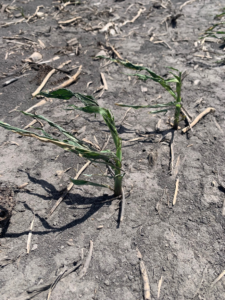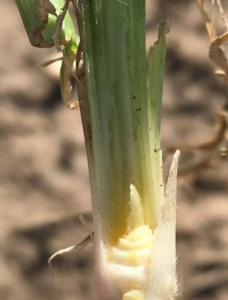Injury from wind, hail, or frost can make a great stand of young corn look terrible. But when it is at V5 or earlier the growing point is protected as it is still belowground.
What determines if the plant will survive and provide an adequate yield?
The health of the growing point will determine if the plant will survive. Although the aboveground tissues may be severely damaged, the growing point should be ok if it is still belowground. To check the health of the growing point, pull a plant from the soil and use a sharp knife to slice the plant in half longitudinally to expose the growing point. A healthy growing point and surrounding tissues will be firm and yellow-white colored (Figure 2). If the growing point is discolored and soft, it most likely will not survive.

Figure 1. Early-season wind injury to corn.

Figure 2. A healthy corn growing point.
What about twisted whorls, will the plant grow out of it?
Wind damage may result in twisted whorls, and unfavorable environmental conditions may prolong recovery. Warm and sunny days will speed up corn plant growth, reducing the time it takes for the plant to recover.
When should the stand be assessed to determine if it is adequate?
Patience is key. Under good growing conditions, the stand can be assessed in 4 days; however, if it is cool and cloudy, you may need to wait up to 10 days. Injured plants should clearly show regrowth; if not, a replant may be necessary.
How can the stand be assessed?
We have a spotlight that provides information on assessing the stand and economics of replanting at https://www.dekalbasgrowdeltapine.com/en-us/agronomy/corn-replanting-decisions.html
